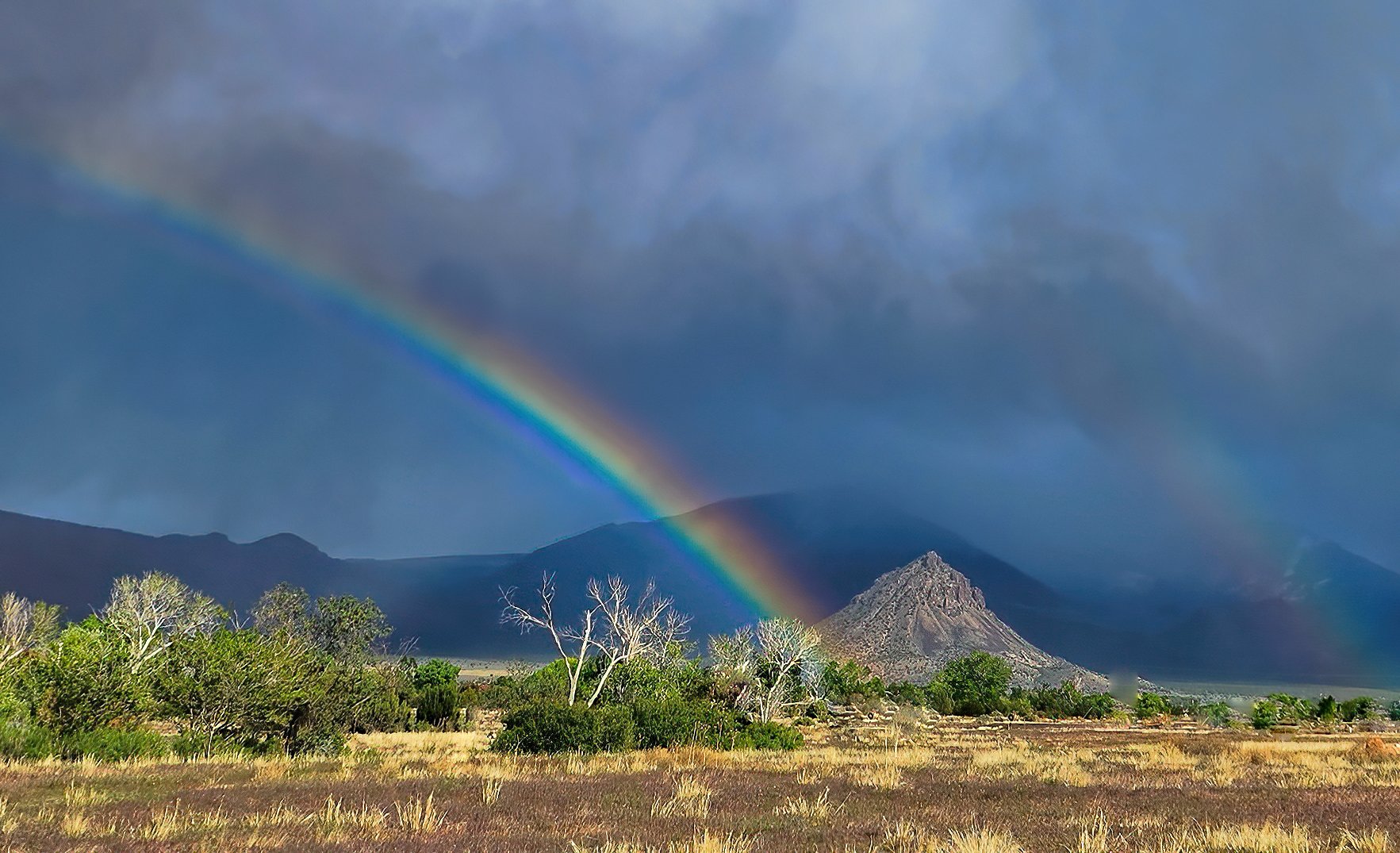hang from the cloud base above Castleton Tower and Adobe Mesa as a squall line moves through Castle Valley this late afternoon.
Shake hands with this wildflower...
and you’ll immediately understand where it gets its name. And it’s the biggest sunflower on the Colorado Plateau.
Rough mules ears (Wyethia scabra).
The rodent relocation project has commenced...
for the season in an effort to stop the destructive digging of these otherwise amusing critters before it gets out of control. This is number two.
Rock squirrel (Otospermophilus variegatus).
The size of your little finger...
and able to fly backwards, hummingbirds are amazing avian aviators.
Black-chinned Hummingbird (Archilochus alexandri).
Ears like periscopes...
extend above the cheatgrass as Bugs Buddy nibbles away on leafy greens.
Desert cottontail (Sylvilagus audubonii).
Bright aurora shine over southern Utah...
in an enormous geomagnetic storm this evening, the largest in nearly 20 years. Here are several wide views captured shortly after midnight of the rare (at this latitude) and dynamic light show. Behold the Aurora Borealis in its fullest expression.
The phenomenon began with quite a bit of color variation directly to the north. Parriott Mesa in silhouette on the right.
A gradual color shift towards orange and red occurred very slowly.
The brighter curtains of light moved gradually towards the northeast over a period of about an hour. Castleton Tower at far right.
UPDATE: Here’s a nice summary of the event by our local scribe: Aurora borealis brightens Castle Valley with a colorful display.
Two-thousandths of a second...
is still not a fast enough shutter speed to sharply freeze the wingbeat of a hummingbird. Here’s one tanking up while on the wing at the sugar dispenser.
Black-chinned Hummingbird (Archilochus alexandri).
There must be gold in Round Mountain...
if this evening’s rainbow is a guide.
Mudcracks...
Resuming launch activities...
at the Round Mountain Missile Test Range, taking advantage of a weather window with calm winds. Flying model rockets is fun beyond description, but maybe it’s a guy thing.
The painted MOAB model rocket leaping off the pad to a 622 foot high apogee.
Zephyr under chute and softly landing below Round Mountain.
Blue-headed beauties invade the feeders...
in greater numbers as they migrate through the area. Here are a couple of more snapshots of this very attractive springtime visitor. They’re both voracious and defensive little bullies while feeding.
Lazuli Bunting (Passerina amoena).
More about the Lazuli Bunting.
More lapis lazuli loveliness...
in the eponymously named bird, with now more than a dozen individuals pecking around the feeding stations. Gorgeous but tiny birds in the Cardinal family.
Lazuli Bunting (Passerina amoena).
Link to the mineral lapis lazuli.
Note to self: These images would be better if I cleaned the windows.
UPDATE 2 May 2024: Here’s an image, caught in direct sunlight, through clean windows.
Whipple’s fishhook cactus...
is in full vivid fuchsia mode and doing its thing attracting pollinators.
Whipple’s fishhook cactus (Sclerocactus whipplei).
The most colorful bird at the feeders...
has arrived for spring, ranks high on my favorite’s list, and is named after a lovely and intensely blue mineral. It’s a furtive fellow and consequently somewhat difficult to photograph.
Lazuli Bunting (Passerina amoena), a male, in breeding plumage.
The "Tip o' the Mesa" geocache...
on the high and pointy prow of Adobe Mesa was established by yours truly 10 years ago this month, and it was logged for only the third time just two days ago by an intrepid adventurer. It takes determined effort and the better part of a day to make it out to the end of the mesa from the Castleton-Gateway Road. The logged comment was terse: “Stunning view.” Yep.
The prominent prow of Adobe Mesa stands 1,800 feet above the viewer in this image.
Fun activity: GEOCACHING.
April showers...
bring out rainbows.
Mostly a glorified campground...
with minimal paleontological interpretation, future visitors to Utahraptor State Park are likely to be somewhat disappointed. The local chapter of the Utah Friends of Paleontology hosted a presentation delivered by park manager Joshua Hansen this evening where he provided some details on the new park being developed north of Moab.
I’ve requested that this diagram be posted on-line so that the public can understand the development plan. One will still be allowed to travel Willow Springs Road and Dalton Wells Road without paying an entrance fee.
Vibrant red wildflowers...
are now igniting the high desert with hot spots of brilliant color.
Utah penstemon (Penstemon utahensis).
Claret cup cactus (Echinocereus triglochidiatus).
High power rockets soared today...
above Ray’s Mesa in a remote corner of the Grand Valley in Colorado, just west of Grand Junction near the state line, organized and coordinated by the local Warp Core rocketry club. About a dozen men of all ages participated in the event and huge fun was had by all.
Launch controller Ben’s view of the launch pads, with my two-stage Majestic model rocket on the center launch rail ready for flight, the first of the day. Someone had to fly in order to check the winds aloft and I volunteered this high flyer.
My two-stage boosted Majestic soaring to an apogee of 2,275 feet (693 meters) on two “F” engines, with a successful recovery under parachute for a flight lasting 2 minutes and 18 seconds, softly landing about 150 feet (~50 m) away from the pad.
Dozens of launches were made throughout the morning by the various club members. Nerd alert!
Catching a noontime nap...
in a secluded and shaded spot beneath rabbitbrush, Bugs Buddy catches up on some Z’s.
Desert cottontail (Sylvilagus audubonii).




























